An Introduction to PyTorch & Autograd

Paul O'Grady
#EuroPython, Rimini - 13th July 2017

Paul O'Grady
#EuroPython, Rimini - 13th July 2017
Currently a Data Scientist at ...
Twitter: @paul_ogrady
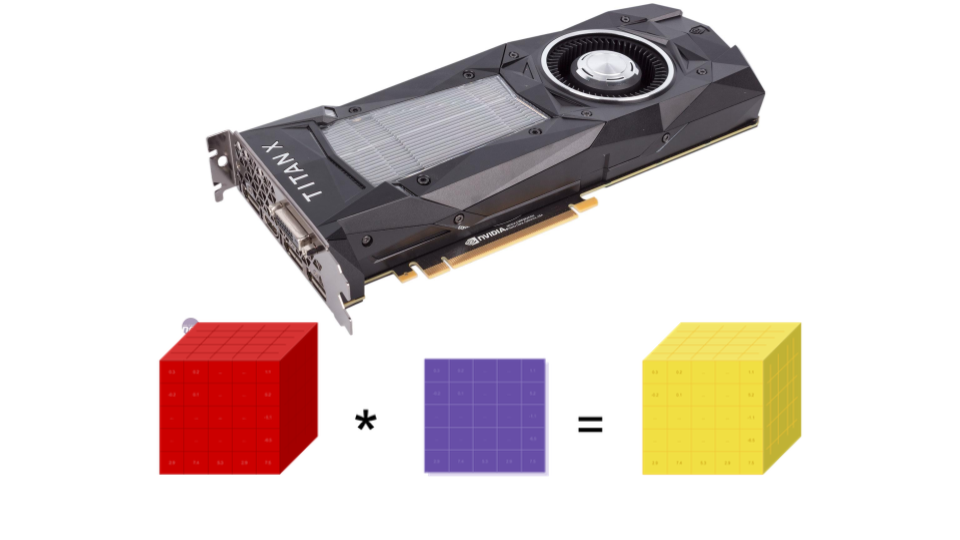
ndarray) operations on the GPUPyTorch is the new kid on the block...
v0.1.6torch.nn - Build & train neural networks/modelstorch.autograd - Automatic differentiationtorch.optim - Optimization algorithmsFollowing examples are for PyTorch Ver 0.1.12 running on Python 3.5.3
Deep Learning landscape:
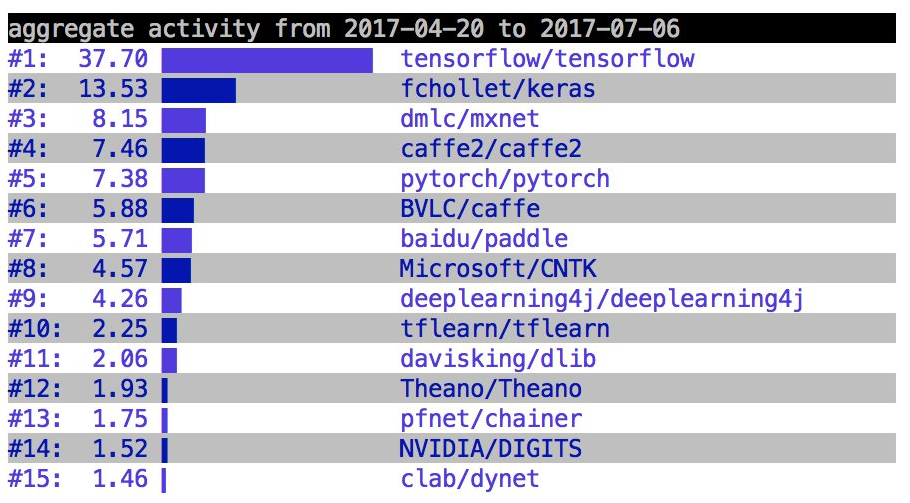
François Chollet (@fchollet)
Tensors are PyTorch's fundamental data abstraction
>>> import torch
>>> x = torch.FloatTensor([[1, 2, 3], [4, 5, 6]])
>>> x
1 2 3
4 5 6
[torch.FloatTensor of size 2x3]
>>> x.size()
torch.Size([2, 3])
Supports in-place & out-place operations
>>> x.add_(torch.ones(2,3) + torch.ones(2,3))
3 4 5
6 7 8
[torch.FloatTensor of size 2x3]
>>> x.sub_(torch.ones(2,3) * 2)
Torch plays well with numpy
>>> import numpy as np
>>> y_np = np.array([[.5,.5,.5], [.5,.5,.5]], dtype='float32')
>>> res = x.numpy() * y_np
>>> res
array([[ 0.5, 1. , 1.5],
[ 2. , 2.5, 3. ]], dtype=float32)
>>> type(res)
<class 'numpy.ndarray'>
Bridge back and forth
>>> z = np.matrix([[2.,2.], [2.,2.], [2.,2.]], dtype='int16')
>>> x.short() @ torch.from_numpy(z) # `mm` method
12 12
30 30
[torch.ShortTensor of size 2x2]
Reshape tensors using views
>>> x.view(1,6)
1 2 3 4 5 6
[torch.FloatTensor of size 1x6]
Tensor computation can be moved to and from GPU
>>> if torch.cuda.is_available():
... x = x.cuda()
... y = torch.from_numpy(y_np).cuda()
... x + y
1.5000 2.5000 3.5000
4.5000 5.5000 6.5000
[torch.FloatTensor of size 2x3]
>>> x.cpu()
1 2 3
4 5 6
[torch.FloatTensor of size 2x3]
torch.autograd packageTensor that allows forrequires_grad=Truevolatilerequires_grad allows calculation of gradients w.r.t the variable
>>> from torch.autograd import Variable
>>> x = Variable(torch.Tensor([1., 2., 3]), requires_grad=False)
>>> y = Variable(torch.Tensor([4., 5., 6]), requires_grad=True)
>>> z = x + y
>>> z.data.numpy()
array([ 5., 7., 9.], dtype=float32)
Variables keep history...
>>> z.creator
<torch.autograd._functions.basic_ops.Add object at 0x7fa1d0294908>
>>> s = z.sum()
>>> s
Variable containing:
21
[torch.FloatTensor of size 1]
>>> s.creator # grad_fn on master branch
<torch.autograd._functions.reduce.Sum object at 0x7fa1d0294828>
Chase references to construct a computation graph
>>> def history(var):
... if isinstance(var, Variable):
... print(var.data.numpy())
... else:
... print(str(type(var).__name__))
...
... if hasattr(var, 'previous_functions'):
... for func in list(var.previous_functions)[::-1]:
... history(func[0])
>>> s += 1
>>> history(s.creator)
AddConstant
Sum
Add
[ 4. 5. 6.]
[ 1. 2. 3.]
>>> s._version
1
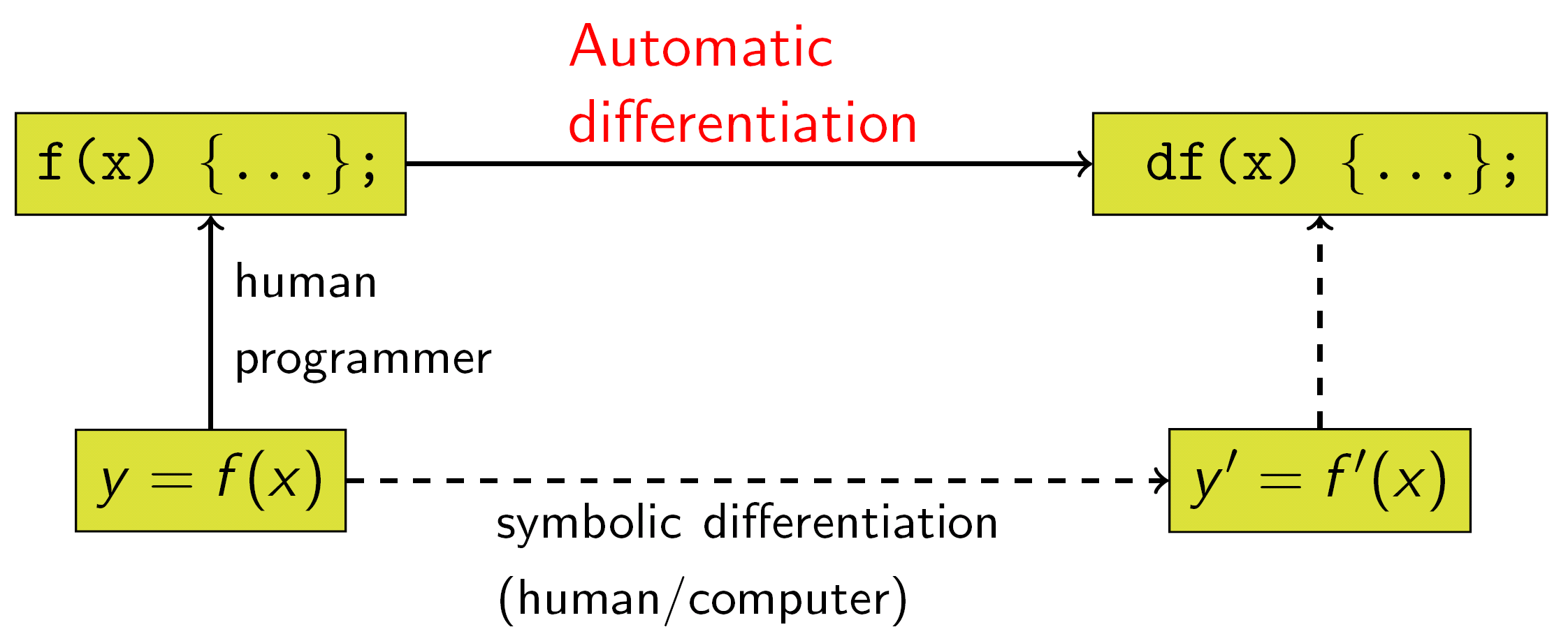
torch.autograd provides classes and functions implementing automatic differentiation of arbitrary scalar valued functions.Tensors to Variables!
Used to calculate the gradient of the loss function with respect to the model parameters/layers
Uses the chain rule to iteratively compute gradients for each layer:
where \(z=f(y)\) & \(y=g(x)\).
e.g. \({\frac {d}{dx}} (3x + 1)^2 = 6(3x + 1)\)
Autograd implements Backpropagation: torch.autograd.variable.backward
Derivative of a function gives gradients
Example for \(sin(x)\)
>>> x = Variable(torch.Tensor(np.array([0., 0.5, 1., 1.5, 2.])
... * np.pi), requires_grad=True)
>>> out = torch.sin(x)
>>> x.grad
>>> out.backward(torch.Tensor([1., 1., 1., 1., 1.])) # d(out)/dx
>>> out.data.int().numpy()
array([ 0, 1, 0, -1, 0], dtype=int32)
>>> x.grad.data.int().numpy() # Gradients
array([ 1, 0, -1, 0, 1], dtype=int32)
>>> torch.cos(x).data.int().numpy()
array([ 1, 0, -1, 0, 1], dtype=int32)
Deep in PyTorch...
from torch.autograd import Function
class Sin(Function):
@staticmethod
def forward(ctx, i):
ctx.save_for_backward(i)
return i.sin()
@staticmethod
def backward(ctx, grad_output):
i, = ctx.saved_variables
return grad_output * i.cos()
backward contains gradient formula
Extend PyTorch by creating your own Functions
Quadratic function:
Determine gradient at \(x=-1\)
>>> x = Variable(torch.Tensor(np.linspace(-2, 4, 100)),
... requires_grad=True)
>>> y = x**2 - 2*x - 3
# Calculate the gradient for x=-1
>>> target = -1
>>> ind = np.where(x.data.numpy() >= target)[0][0]
>>> gradients = torch.zeros(100,1)
>>> gradients[ind] = 1
>>> y.backward(gradients)
Determine gradient & tangent line
>>> x_val = float(x[ind].data.numpy())
>>> y_val = float(y[ind].data.numpy())
>>> m = float(x.grad.data.numpy()[ind])
>>> m
-3.939393997192383
# Calculate tangent
>>> y_tangent = m*(x - x_val) + y_val
>>> x = x.data.numpy()
>>> y = y.data.numpy()
>>> y_tangent = y_tangent.data.numpy()
>>> plt.plot(x, y, 'g', x[5:30], y_tangent[5:30], 'b',
... x_val, y_val, 'ro')
>>> plt.title('$f(x) = x^2 - 2x - 3$')
>>> plt.show()
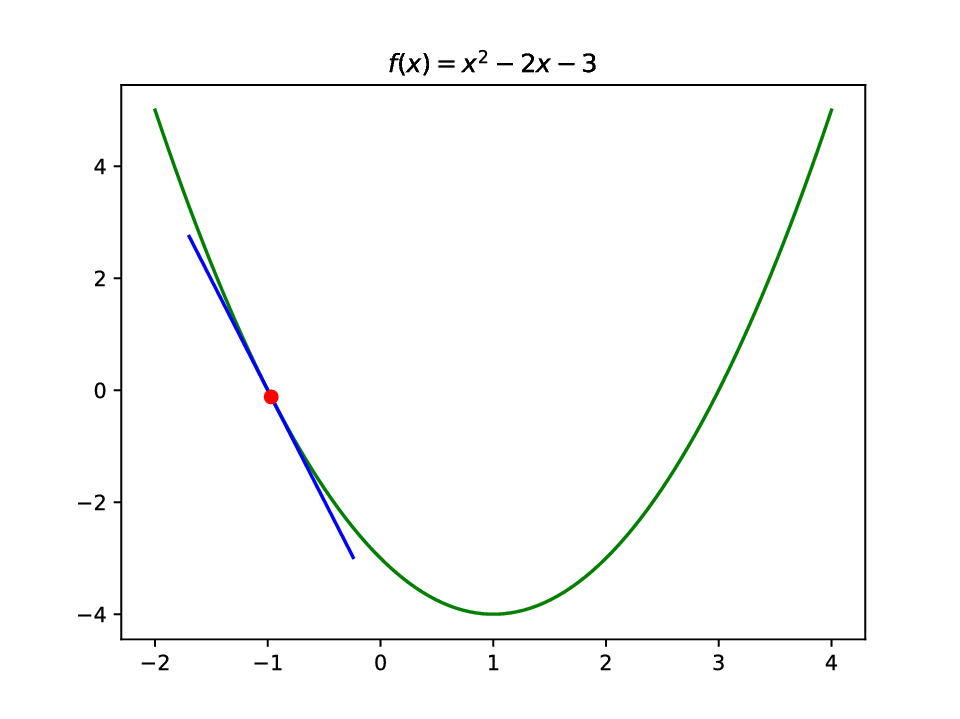
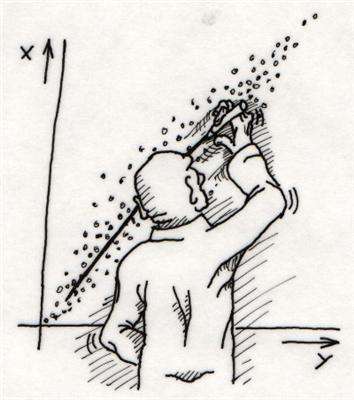
Fit a line to the data: minimize the distance between the points and the line
Model relationship between \(x\) & \(y\):
PyTorch affine/linear model: torch.nn.Linear
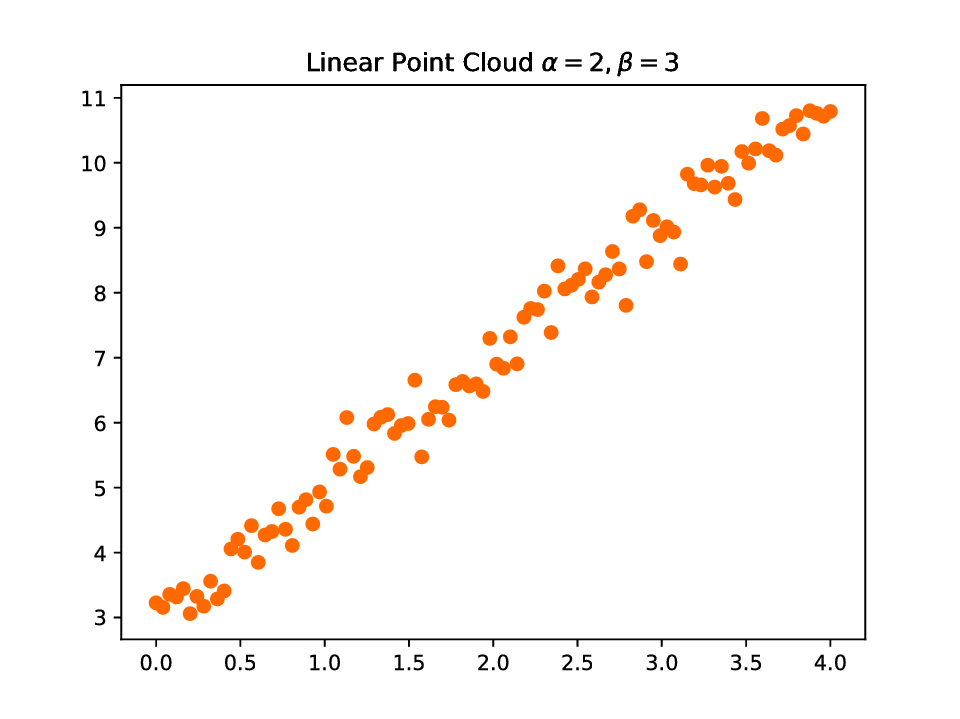
ML requires: model, cost function & learning alg.
Mean Square Error: (torch.nn.MSELoss)
where \(\hat{y_{i}}\) is the predicted value & \(y_{i}\) is the true value.
Stochastic Gradient Descent: (torch.optim.SGD)
where \(\theta\) are the model parameters, \(\eta\) is the learning rate & \(\nabla L(\theta)\) is the gradient of the parameters.
Create data
>>> alpha = 2; beta = 3
>>> x = np.linspace(0, 4, 100)
>>> y = alpha * x + beta + np.random.randn(100) * 0.3
>>> x = x.reshape(-1, 1) # convert to column vectors
>>> y = y.reshape(-1, 1)
Instantiate model
>>> class LinearRegressionModel(nn.Module):
... def __init__(self, input_dim, output_dim):
... super(LinearRegressionModel, self).__init__()
... self.linear = nn.Linear(input_dim, output_dim)
...
... def forward(self, x):
... out = self.linear(x)
... return out
...
>>> model = LinearRegressionModel(input_dim=1, output_dim=1)
Instantiate criterion & optimizer. Prepare training data
>>> criterion = nn.MSELoss()
>>> optimizer = torch.optim.SGD(model.parameters(), lr=0.01)
>>> inputs = Variable(torch.from_numpy(x.astype('float32')))
>>> labels = Variable(torch.from_numpy(y.astype('float32')))
Inspect model parameters
>>> list(model.named_parameters())
[('linear.weight', Parameter containing:
2.3494
[torch.FloatTensor of size 1x1]
), ('linear.bias', Parameter containing:
2.1157
[torch.FloatTensor of size 1]
)]
Train model over 250 epochs
>>> for epoch in range(250):
... # 1. Clear gradients w.r.t. parameters
... optimizer.zero_grad()
...
... # 2. Forward to get output
... outputs = model(inputs)
...
... # 3. Calculate Loss (Scalar value)
... loss = criterion(outputs, labels)
...
... # 4. Calculate gradients w.r.t. parameters
... loss.backward()
...
... # 5. Updating parameters
... optimizer.step()
Define-By-Run
Inspect learned parameters
>>> list(model.named_parameters())
[('linear.weight', Parameter containing:
2.3221
[torch.FloatTensor of size 1x1]
), ('linear.bias', Parameter containing:
2.1034
[torch.FloatTensor of size 1]
)]
Inspect network modules/layers
>>> for idx, m in enumerate(model.named_modules()):
... print(idx, '->', m)
...
0 -> ('', LinearRegressionModel (
(linear): Linear (1 -> 1)
))
1 -> ('linear', Linear (1 -> 1))
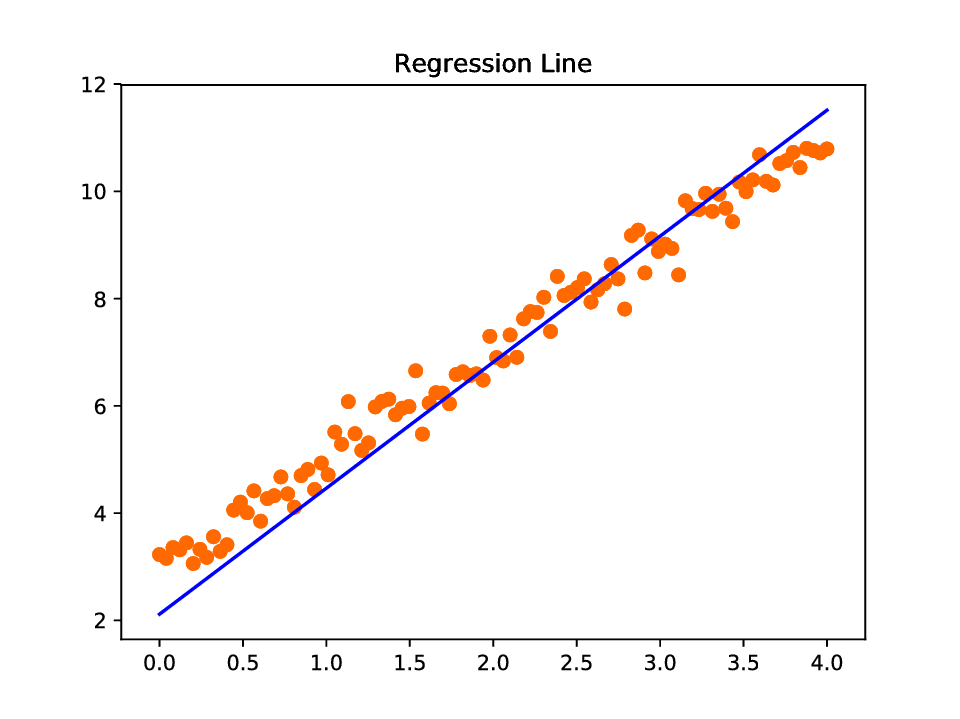
Contrast with Theano; Model setup
>>> import theano
>>> from theano import tensor as T
>>> import numpy as np
>>> # Generate training data
>>> trX = np.linspace(-1, 1, 101)
>>> trY = 2 * trX + np.random.randn(*trX.shape) * 0.33
>>> # Symbolic variable initialization
>>> X = T.scalar()
>>> Y = T.scalar()
>>> # Define model
>>> def model(X, w):
... return X * w
>>> # Model parameter initialization
... w = theano.shared(np.asarray(0., dtype=theano.config.floatX))
>>> y = model(X, w)
Model training
>>> # Define cost function, gradient and update rule
>>> cost = T.mean(T.sqr(y - Y))
>>> gradient = T.grad(cost=cost, wrt=w)
>>> updates = [[w, w - gradient * 0.01]]
>>> # Compile to a Python function
>>> train = theano.function(inputs=[X, Y], outputs=cost,
... updates=updates, allow_input_downcast=True)
>>> # Run for 100 iterations
... for i in range(100):
... for x, y in zip(trX, trY):
... train(x, y)
No opportunity to change things within Loop

